- Prelude
- Editorial
- Subodh's 'return home'
- A Conversation with TV Santosh
- It's a War Out There
- Raqib Shaw
- Illusions in Red from a very British Indian Sculptor
- Stand Alone: Shibu Natesan
- Reading Atul Dodiya
- Bharti Kher: An Obsession for Bindis
- Bose Krishnamachari
- The Image - Spectacle and the Self
- From Self-depiction to Self-reference: Contemporary Indian Art
- GenNext: The Epitome of New Generation Art
- Kolkata's Contemporary Art A Look in the Mirror
- Innovation Coalesced with Continuing Chinese Qualities
- Kala Bhavana-Charukala Anushad Exchange Program
- Montblanc Fountain Pens
- Dutch Designs: The Queen Anne Style
- Bangalore Dance Beat
- Decade of change
- Distance Between Art & It's Connoisseur
- What Happened and What's Forthcoming
- 3rd India Art Summit
- New Paradigms of the Global Language of Art
- Black Brown & The Blue: Shuvaprasanna
- Art Events Kolkata
- Musings from Chennai
- Art Bengaluru
- Printmaker's Season
- Mumbai Art Sighting
- The Pause of Profound Stillness
- Previews
- In the News
- The Rebel Queen: An icon of her own times yet looked down upon
ART news & views
Dutch Designs: The Queen Anne Style
Volume: 3 Issue No: 14 Month: 3 Year: 2011
Furniture
by Amitabh Bachhawat
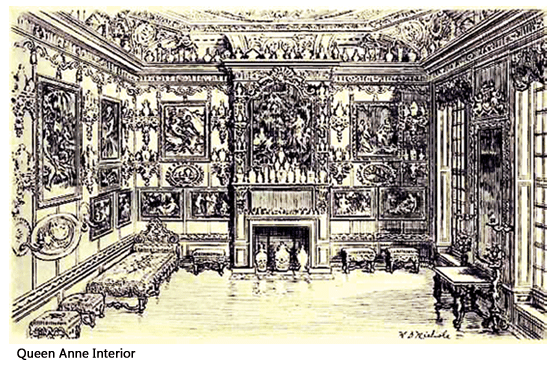
The Queen Anne period was the first great period of Furniture as a fashion or status symbol. The English craftsmen learned the foreign techniques and started to develop a distinct English style. There was an influence of Dutch in the furniture designs of this period. Queen Anne was crowned as Queen of England in 1702 succeeding William, dying briefly in 1714. 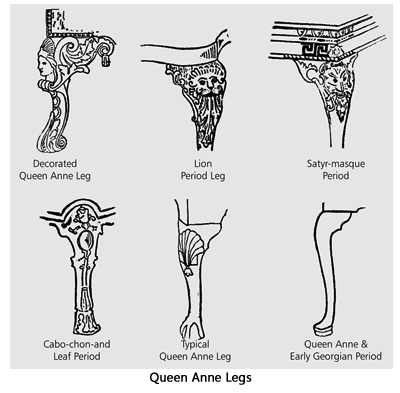 She was the last monarch of the House of Stuarts. The Queen Anne style is a refinement of the William and Mary style with lighter, graceful, more comfortable furniture. The development of design in the furniture during this brief period actually had an origin prior to accession of Queen Anne, the year 1690 when the Glorious Revolution placed the Prince of Orange on the throne of England. William being a Dutch there was a great influence of Netherlands on England. England was used to defend the aggression of Louis IV of France against Netherlands. On her accession Queen Anne followed William's policy and England might have regarded as Dutch province. Considering the close dynastic, political, mercantile and religious ties between the two countries, the Dutch tastes dominate England.
She was the last monarch of the House of Stuarts. The Queen Anne style is a refinement of the William and Mary style with lighter, graceful, more comfortable furniture. The development of design in the furniture during this brief period actually had an origin prior to accession of Queen Anne, the year 1690 when the Glorious Revolution placed the Prince of Orange on the throne of England. William being a Dutch there was a great influence of Netherlands on England. England was used to defend the aggression of Louis IV of France against Netherlands. On her accession Queen Anne followed William's policy and England might have regarded as Dutch province. Considering the close dynastic, political, mercantile and religious ties between the two countries, the Dutch tastes dominate England.
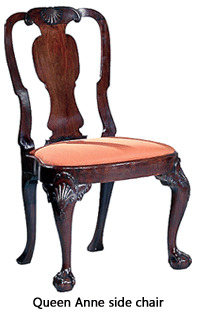
It was the Dutch taste tempered with French art that formed the basis of the Queen Anne style. The French forced the Louis IV style on England and other low countries by Revocation of Edict of Nantes in 1685. As a result of that edict, many thousands of the best workmen in the French arts and crafts were forced to go into exile, taking refuge in England, Germany and Holland. There they were welcomed by their co-religionists, and their labours had a great and immediate influence on the native styles. The artist who exerted the greatest influence in forming the Queen Anne style was Daniel Marot, who left France in 1686 and went to Holland. When William became King of England in 1690, he appointed Marot his chief architect and master of works. Marot designed the interior decorations and furniture for many mansions and palaces in England and Holland. The names of many joiners, carvers and goldsmiths (who at that day designed many minor pieces of furniture) are to be found in the lists of Huguenot refugees in London.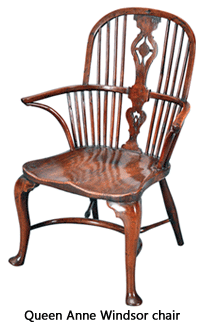
Trade with the Far East, however, was probably a more important factor in the formation of the Queen Anne style than any other influence. The Oriental taste had reached Amsterdam and London before Paris felt it. Throughout the Seventeenth Century, the English and Dutch East Indiamen poured porcelain, lacquer, and other products of Oriental art into their respective capitals. In England, porcelain had been a comparatively rare luxury confined to the tables and closets of rich collectors until about 1630. Cromwell laid a heavy duty on it. China-shops under the Restoration became one of the favourite lounging-places of fops and curiosity hunters. Emporiums of Oriental wares were known as India houses. With such tastes in high places, it is not astonishing to find a popular favour for China and everything Oriental, spurious and real. This Chinese taste affected everything in architecture and interior decoration.
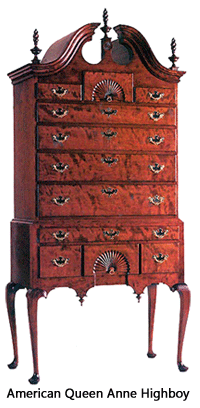 The requirement of effective display of the Chinese porcelain changed the interior decoration. Furniture was designed to display the china, large display cabinets, wall brackets and chimney pieces were designed to hold and display china. A glance through Marot's book of designs will show a most lavish use of china as an integral part of interior decoration. He piles up his chimney-pieces with tier on tier on shelves loaded with porcelain of all shapes and sizes, arranged, however, with an eye to symmetry. Brackets up the walls, in the corners, and between the panels, all along the cornice, and over the door are loaded with cups, bowls, and vases. The panels themselves are sometimes painted with Chinese subjects, or covered with real Oriental painted or embroidered fabrics. Besides displaying china, there was drinking tea. The relatively new custom of drinking tea socially became popular, and to a certain extent, the taking of coffee and chocolate was also welcomed. To accommodate this practice, a great number of tea tables were produced by skilled craftsmen. Such tea tables came in a variety of shapes, from rectangular to round. Most of them had a tray-like molding on top. Many of the small tables had tops which could be tilted for storage when not in use. Furniture was designed for specific purposes as with increase in wealth and people could afford to socialize more. Large number of game tables and other serving tables were designed. Small ladies writing tables were also popular during this period.
The requirement of effective display of the Chinese porcelain changed the interior decoration. Furniture was designed to display the china, large display cabinets, wall brackets and chimney pieces were designed to hold and display china. A glance through Marot's book of designs will show a most lavish use of china as an integral part of interior decoration. He piles up his chimney-pieces with tier on tier on shelves loaded with porcelain of all shapes and sizes, arranged, however, with an eye to symmetry. Brackets up the walls, in the corners, and between the panels, all along the cornice, and over the door are loaded with cups, bowls, and vases. The panels themselves are sometimes painted with Chinese subjects, or covered with real Oriental painted or embroidered fabrics. Besides displaying china, there was drinking tea. The relatively new custom of drinking tea socially became popular, and to a certain extent, the taking of coffee and chocolate was also welcomed. To accommodate this practice, a great number of tea tables were produced by skilled craftsmen. Such tea tables came in a variety of shapes, from rectangular to round. Most of them had a tray-like molding on top. Many of the small tables had tops which could be tilted for storage when not in use. Furniture was designed for specific purposes as with increase in wealth and people could afford to socialize more. Large number of game tables and other serving tables were designed. Small ladies writing tables were also popular during this period.  Among the entire furniture pieces, chair is the single item that most typifies any one period and there is no exception with this period. The Queen Anne Chair is very well known and still popular today.
Among the entire furniture pieces, chair is the single item that most typifies any one period and there is no exception with this period. The Queen Anne Chair is very well known and still popular today.
The forms of furniture in the Queen Anne period show, in the first place, the discontinuance of certain types that had enjoyed high favour in the days of William and Mary. The perpendicular legs of chairs, settees, stools, tables and highboys with the inverted-cup turnings, shaped stretchers and bun feet, went quite out of fashion, being superseded by legs of cabriole form. Backs of chairs, especially the backs of upholstered chairs, which had hitherto risen to a great height, were made lower, as were also the backs of settees. Cornices about the tops of double chests and cabinets lost their prominent ovolo or torus frieze. The single and double hooded tops of cabinet work developed a modification - a kind of modified ogee superstructure above the double hood motif. The study of Queen Anne furniture is suitably divided into five groups for their respective form and decoration. The Decorated Queen Anne, 1714 to 1725; with greater elaboration of carving than was formerly the fashion, the chief motifs being more cockle shells, occasionally with  pendent husks below them, distributed on the knees of chairs, settees and tables and the backs and seat rails of chairs and settees; vigorously carved claw-and-ball feet and boldly executed eagles' heads to terminate the arms of chairs and settees, the same design occurring also at times in the backs. The lion period, 1720 to 1735; brought lions' heads on the knees, backs and seat rails of furniture. The feet were oftentimes lions' paws. The Satyr-masque period, 1730 to 1740; furniture had grotesque heads where before were lions' heads. The Cabo-chon-and-leaf period, 1735 to the rise of Chippendale; gave way to the “cabochon-and-leaf" motif which Chippendale used as an important factor in "the design-basis of his earliest manner".
pendent husks below them, distributed on the knees of chairs, settees and tables and the backs and seat rails of chairs and settees; vigorously carved claw-and-ball feet and boldly executed eagles' heads to terminate the arms of chairs and settees, the same design occurring also at times in the backs. The lion period, 1720 to 1735; brought lions' heads on the knees, backs and seat rails of furniture. The feet were oftentimes lions' paws. The Satyr-masque period, 1730 to 1740; furniture had grotesque heads where before were lions' heads. The Cabo-chon-and-leaf period, 1735 to the rise of Chippendale; gave way to the “cabochon-and-leaf" motif which Chippendale used as an important factor in "the design-basis of his earliest manner".

Walnut was the preferred wood with the Queen Anne period and often referred to as the Age of Walnut. Toward the end of this period mahogany gained in popularity. Upholstered furniture was introduced for the first time in the form of a padded wing chair. The Dutch influence that prevailed during this period naturally resulted in marquetry coming into very high favour. The ordinary cabinet woods were inlaid in geometrical, floral and animal patterns with the warmer and more beautiful tints of the exotic woods. Complete pictures were often formed on broad surfaces, such as table tops, and narrower surfaces were also decorated in this manner. 'Japanning' came into the fashion which gave the furniture a lacquered finish to make it look as if it came from the Orient.
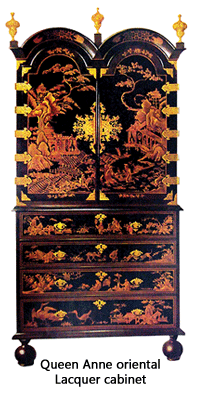 In America, the Queen Anne furniture style did not get its hold on the popular taste until the monarch whose name it bore was dead and the first of the Hanoverian Georges was nearly half through his reign. But it continued in favour right up to the time when the impact of Chippendale designs made themselves felt in American furniture craftsmanship. One must, of necessity, be a little vague as to the years of the Queen Anne furniture style in America, about 1720 to 1760 is a fair estimate. Majority of craftsmen producing it were native born. So their designs did not directly copy those of England. They had a certain individuality that makes it easy to distinguish American Queen Anne furniture from that of England. The American pieces have distinct grace but they are less ornate. It was during this period that the native woods came into their own use. At the same time, these American Queen Anne furniture examples mark a sharp cleavage from both the preceding William and Mary Period and the sturdy but somewhat heavy Seventeenth Century furniture, Tudor like in its construction of panels, stiles, and rails. There was grace, lightness, and delicacy of detail, which struck a new note in American furniture.
In America, the Queen Anne furniture style did not get its hold on the popular taste until the monarch whose name it bore was dead and the first of the Hanoverian Georges was nearly half through his reign. But it continued in favour right up to the time when the impact of Chippendale designs made themselves felt in American furniture craftsmanship. One must, of necessity, be a little vague as to the years of the Queen Anne furniture style in America, about 1720 to 1760 is a fair estimate. Majority of craftsmen producing it were native born. So their designs did not directly copy those of England. They had a certain individuality that makes it easy to distinguish American Queen Anne furniture from that of England. The American pieces have distinct grace but they are less ornate. It was during this period that the native woods came into their own use. At the same time, these American Queen Anne furniture examples mark a sharp cleavage from both the preceding William and Mary Period and the sturdy but somewhat heavy Seventeenth Century furniture, Tudor like in its construction of panels, stiles, and rails. There was grace, lightness, and delicacy of detail, which struck a new note in American furniture.
Queen Anne herself may have served her country only a dozen years, but the furniture style in her name lasted for the better part of a century in England and in America. Even beyond the American Revolution, its distinguished form could be found in smaller villages of the newly-formed country. The Forms and the motifs of the period are still relevant in present context of Modern and Contemporary Furniture design.